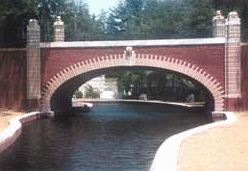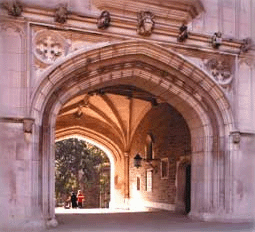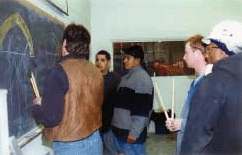Arches Are In
By Maria Viteri, AIA, Matthew Stokes Redabaugh
 Georgian Court Bridge, Lakewood, NJ Best in Category Restoration projects 1999 NJ Golden Trowel Awards |
The historical success of arches is based on an understanding of the structural advantage ? the use of compression in dealing with loads and stresses. The aesthetic appeal is based on flexibility related to form. A masonry arch can take on a variety of shapes, all the while responding to balance, proportion and scale in design. A masonry arch's great resistance to compression makes it the most efficient structural element in dealing with spanning openings.
Arches have been historically constructed with unreinforced masonry. In an unreinforced state, the masonry arch has been used to span various size openings and across considerable lengths. Due to the curvature characteristics of the arch design, it provides great structural efficiency that successfully transfers vertical loads and vertical forces. Because of masonry's compressive strength, masonry arches can support considerable load.
However, while history points to hundreds of masonry-only examples of arch construction, today we are seeing a combination of materials. While typical, this trend is usually not necessary, and may even have a compromising effect on building performance.
"Ask a brick what it wants to be, it will say an arch!" ? Louis Kahn
If, as the saying goes, a brick wants to be an arch, why do we see combinations of materials? The possible answers range from general misunderstanding of arch design to a comfort level in the craftworker constructing the arch. Both issues can be addressed in a positive and more importantly, cost effective manner.
Masonry arches in their traditional application serve many sizes of openings without the need for additional reinforcement. It is not until very long spans or very small rises are incorporated in arch design that reinforcement need be considered. A reduction in the area of masonry used as abutment might also require the use of reinforcement for load resistance.
 Blair & Buyers Hall, Princeton University, Princeton, NJ Best in Category Restoration Projects 2001 NJ Golden Trowel Awards |
More importantly, often the introduction of additional materials into a masonry arch reduces the benefits of single trade responsibility as related to tolerances and overall building performance.
The introduction of non-masonry materials presents a variety of challenges to the mason craftworker. Along with scheduling complications, consideration should also be given to how a non-masonry trade may affect the overall tolerances in the final arch.
By code, tolerances differ from material to material. Masonry materials are often required to adhere to tolerances that are more stringent than other materials, such as structural steel. As such, it is possible to have both materials fall within industry tolerance and still face significant coordination issues.
The higher permitted variances in structural steel, for example, can adversely effect the more strict tolerances required of masonry. Loose tolerances can lead to the entry of water and moisture, factors that ultimately have a negative impact on the building's overall performance. In an all masonry arch, this possibility does not exist.
Today the masonry education extended to young designers by The International Masonry Institute, Bethesda, Md., includes arch design and arch construction principles. Young designers are eager to understand how they can introduce unreinforced masonry arches in their building projects.
This eagerness is particular apparent at IMI's annual Masonry Camp, which brings together apprentice masons and intern architects or graduate students to learn the value of collaboration through a design/build challenge, and the beauty of masonry through hands-on familiarization sessions with skilled union instructors. At Masonry Camp, a lecture on arches is often the highlight of the week, and an inspiration to participants as they build one element of their design/build challenge.
What do you want to build?
After asking a brick what it wants to be, the logical next question is, "What does a mason want to build?" It's likely the answer will be the same. Getting to that answer, however, lies in establishing a comfort level with the craftworker.
 During his arches lecture at IMI Masonry Camp, Special Projects Coordinator Matt Redabaugh tries to convey the arch's timelessness, in both its predictability as a functional masonry form, and its potential for beauty. |
Both construction principles and practical application are taught through the IMI apprenticeship and training system. An ongoing Arches class at the National Training Center and regional centers is offered to all levels of craftworker, from pre-apprentices to seasoned journeymen and women, as well as to all IMI and BAC (The International Union of Bricklayers and Allied Craftworkers) instructors through the annual Instructor Certification Program.
Arches take a variety of forms that range from the jack arch to circular and elliptical arches to Gothic. Typically, a designer will select jack, segmental, semicircular and multi-centered arches for building elements. Semicircular arches are often used for very long spans, due to their structural efficiency.
Like any other building element, arches must meet the performance criteria for a building. In addition to structural performance, an arch should address weather issues and general building performance issues. Resistance to water penetration, for example, is a major concern when designing arches.
Historically the mass used in the design and construction of a masonry arch served to provide water penetration resistance. Over time, as wall sections have become thinner, water penetration has become more critical. When provisions against water penetration are required, such as in arches that become an integral part of the building envelope, water resistance can be addressed through the use of a barrier wall or drainage wall system. Regardless of the system selected, the arch should be flashed and include weep holes to best direct water away from the building's interior.
Designers should give thought to the various options available in arch designs. Issues include material selection ? including brick sizes, shapes, bonding patterns and material tolerances. It is important to understand the material being used for the masonry arch to better arrive at a solution that can be easily and effectively constructed.
Additional issues include arch size and arch depths, keystones, soffits, skewbacks and the configuration of abutments. The arch designer should resist out-of-plane loads and address building and thermal movement issues while giving careful consideration to the location of expansion joints.
Finally, it is important to recognize the relationship between workmanship and building performance. Proper masonry arch performance ultimately depends on workmanship and the mason's ability to understand industry guidelines, layout and construction processes.
Assistance with all these considerations and more is available from The International Masonry Institute to participating contractors, as well as to designers. IMI provides technical assistance and education on a per-project basis that assists designers with incorporating arches in their design solution. Additionally, the Brick Industries Association, Reston, Va., publishes technical notes related to the structural design of masonry arches and addresses unreinforced and reinforced solutions.
About the Authors
Maria Viteri, AIA, is Director of Program Development for the International Masonry Institute, and Project Coordinator for Masonry Variations.
Matthew Stokes Redabaugh is the Special Projects Coordinator for the International Masonry Institute.


















